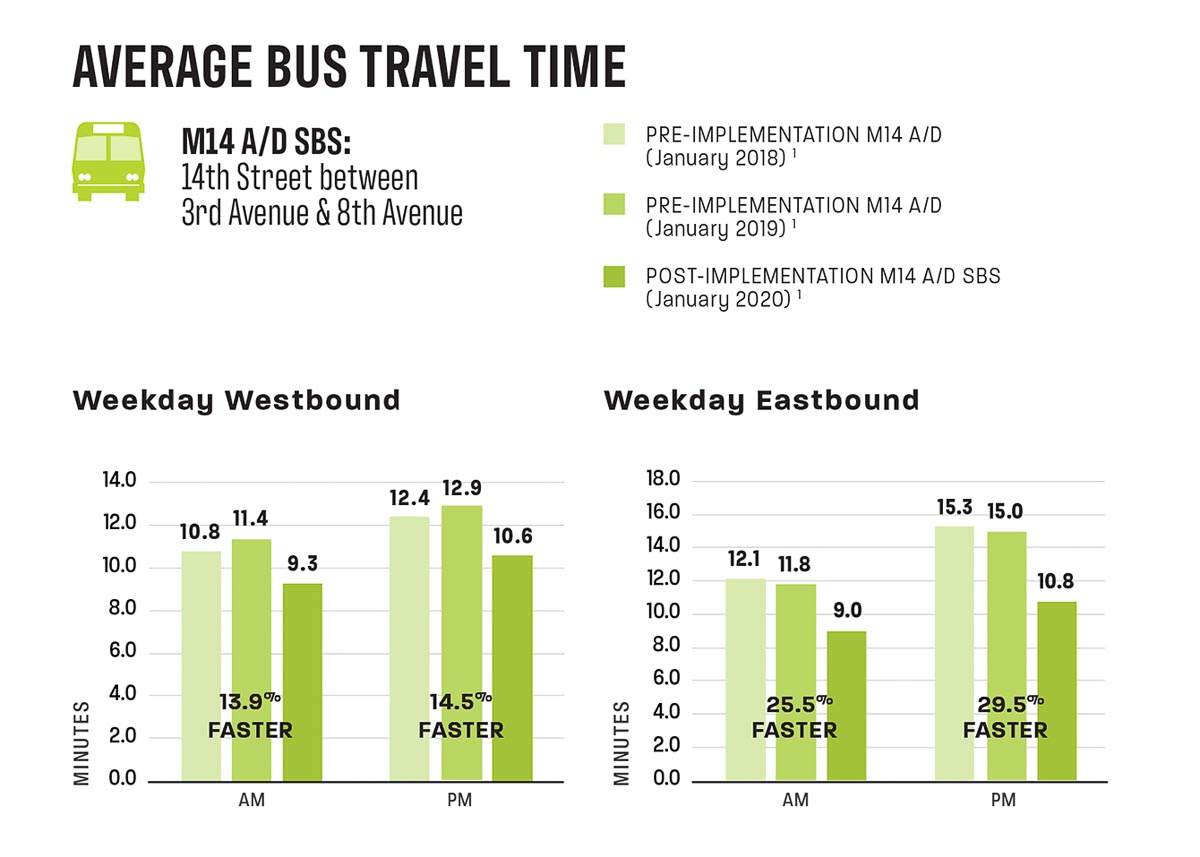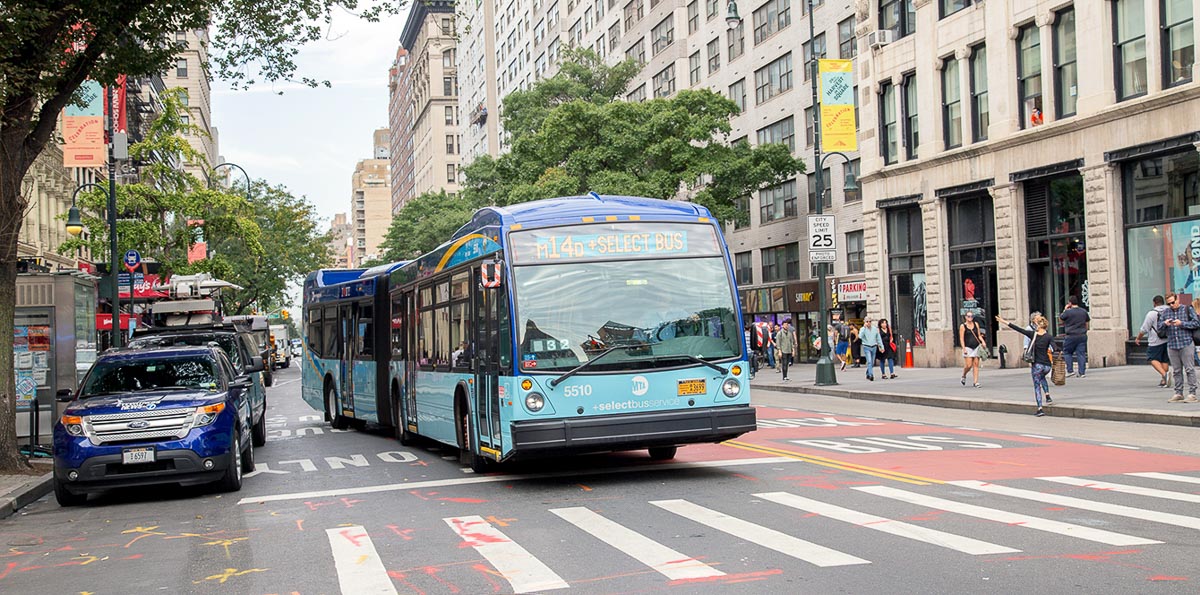Just a year ago, New York took the bold step of restricting traffic on 14th Street in Manhattan to buses and a relative handful of local deliveries. The improvement in local travel conditions was immediate and sustained. Crosstown buses on 14th Street, which had been the city’s slowest, are now blowing past their schedules. According to the latest evaluation report from Sam Schwartz Engineering (completed just prior to the COVID-19 pandemic) bus travel times between 3rd Avenue and 8th Avenue have been cut by 15 to 25%, benefitting thousands of cross-town travelers.
Because the buses are moving so much faster, more people are riding them. The street itself is a livelier, people-oriented place because there are fewer cars. The buses themselves are more efficient and productive (each driver carriers more passengers per hour because their buses are both faster and fuller, which ultimately benefits taxpayers). And contrary to the folk wisdom about traffic displacement, there’s been no detectable increase in car traffic or significant slowdown on the side-streets paralleling 14th Street.

This “Miracle on 14th Street” should be an object lesson to transportation planners in New York and around the country. Dedicating more of our scarce and valuable public space to highly efficient means of moving people can make cities more pleasant, can make transit more productive and efficient, and can make overall transportation better.
Those are reasons enough for cities to look for opportunities to create their own car-free, bus-only streets. But the experience on 14th Street has important implications for another issue: transportation equity.
Kinder Institute Forum: Tamika L. Butler
“Transportation Equity: The Time is Now!” — Butler, a national expert and speaker on issues related to the built environment and equity, will discuss institutional oppression, the importance of inclusive urban design, and how to make transportation and public spaces more equitable.
When: Nov. 11
Register for the free webinar here.
Let’s consider the distribution of costs and benefits of the 14th Street project. To a first approximation, the beneficiaries are bus riders (who get faster travel times) and those who bear the costs are those who can no longer drive there (people in private cars, and those traveling by taxi or other for hire vehicle). There are second order beneficiaries as well: people and businesses on 14th Street have a more pleasant environment, the MTA has more productive buses, faster cross-town connections probably make the whole city transit system more attractive, and so on.
What 14th Street tells us about the equity of tolling
There’s one other angle to consider. While no one describes it this way, but in effect the ban on most car traffic on 14th Street is the equivalent of a very high toll for cars using the street. (You’ll pay a $50 fine for your first offense of driving on 14th Street, escalating by $50 for each subsequent infraction). So, what 14th Street shows us is in a nutshell is the equity implications of the most expensive road pricing regime you can imagine. (Any other toll, including the upcoming congestion pricing scheme for Manhattan will involve much lower charges than the current fine for driving on 14th Street). So, is this prohibitively high toll for 14th Street “equitable?”
The answer is: yes, of course. As we’ve stated before, no urban transportation policy is more equitable than measures that enable buses to move faster. Bus riders (as the New York data bear out) have lower incomes than other urban travelers, and importantly, many have few or no options. If you don’t own or can’t drive a car, and can’t afford a taxi or ride-hailed vehicle, you’re stuck with whatever level of service buses provide. And on shared streets, buses take a back seat to general traffic. Giving buses their own lane or their own street produces big benefits for those who are most disadvantaged by our car-dominated transportation system. Nothing is more equitable than that.
Read our series examining the intersection of race, equity and public transit in America, featuring insights from transit advocates and experts.
Part one: “Racism has shaped public transit, and it’s riddled with inequities”
Part two: “What transit agencies get wrong about equity, and how to get it right”
Part three: “What transit equity means to a transit-dependent rider in a car-centric city”
Part four: “To tackle pandemic racism, we need to take action, not just take to social media”
There’s a growing emphasis on “equitable transportation” in policy discussions around the country. Thinking about equity is long overdue. For too long, transportation planning exercises have simply been about maximizing throughput (of cars) with little or no consideration given to how that affects different people.
But too much of what’s being said about equity is either hopelessly vague or seemingly obsessed with planning processes rather than substantive results.
We’re told that road pricing is inequitable because it’s regressive (that any given toll is a higher fraction of income for low-income people than it is for the overall population). That’s also true, as it turns out, of the price of just about everything, from pizza to coffee to haircuts to parking meters. The common underlying issue in this case is the inequity in the distribution of income, not some intrinsic unfairness in prices. A toll for using a road isn’t a tax, it’s payment for a specific service.
The focus on the supposed inequity of road pricing is routinely divorced from the larger context of the prices we pay for transportation. We don’t give cars away for free (even though they’re very expensive). We don’t give fuel away for free (even though that’s more of a burden for the poor). We require everyone who owns or drives a car to buy insurance (which is both expensive, and often proportionately more expensive for low-income people). You can’t use a public street unless you can afford a car, afford to pay for fuel and pay for government-mandated insurance, which in California costs an average of $150 per month and in Michigan an average of more than $200 a month (and even as much as $400 per month in Detroit).
Continuing to subsidize car travel has the perverse effect of creating more sprawl and more car-dependence, which makes the transportation system even more inequitable.
Engaging in price-fixing to try to address equity concerns is a recipe for failure, and wastefully distributes most of the benefits to higher-income households. Car ownership and use is highest among the highest-income households; subsidizing roads, car travel and parking confers much more benefits on these high-income households than low-income households. In effect, complaints about pricing being inequitable amount to a convenient shield to let the higher-income people who are getting an expensive public service continue to pay little or nothing for it.
In what way is a car-dependent transportation system “equitable?”
Ultimately, the underpricing of transportation leads to a world that is even more sprawling and car-dependent. Distant suburban big-box stores can benefit from the large market for car shopping, while increased travel by car undermines the viability of neighborhood retailers. In contrast, urban environments with transportation systems that allow people to reach common destinations by walking, by transit and by bicycle are inherently more equitable than car-dependent transportation systems. Equity has to be viewed as a system condition, and not measured at the level of microscopic features transport.
And we can’t divorce equitable transportation from equitable land use. If we make it prohibitively expensive for people to live in areas that are walkable and well-served by transit, the problem is really one of housing affordability, not of transportation equity. Continuing to subsidize car travel has the perverse effect of creating more sprawl and more car-dependence, which makes the transportation system even more inequitable.
In America, we have a caste system for transportation: There is a privileged class, those who own cars and can drive them, and there is an under-class, those who can’t afford or aren’t able to drive a car, who must endure a slow, expensive and inadequate system of transit or walking to their destinations. Anything that subsidizes or facilitates car travel generally tends to be inherently inequitable, as it works to the advantage of those who have cars, and makes the world a more difficult and worse place for those who don’t.
And that’s why New York’s “Miracle on 14th Street” is so important: Reallocating a tiny fraction of Manhattan’s road space from car traffic to bus travel is a classic example of how to make the transportation system more equitable (as well as more efficient and productive). It’s the sort of thing — if we’re interested in promoting equity — that we should be doing more of.
This article was originally published on City Observatory.

